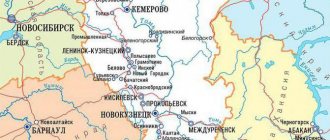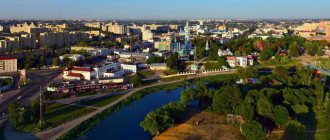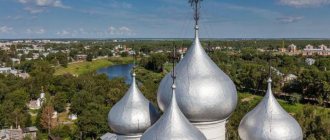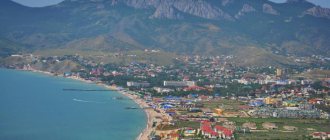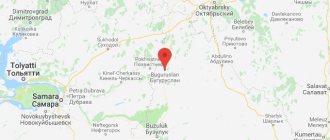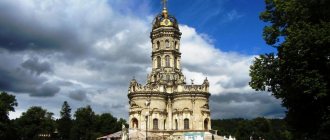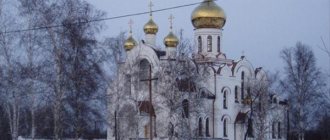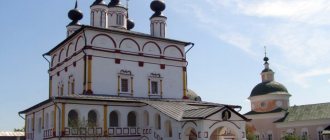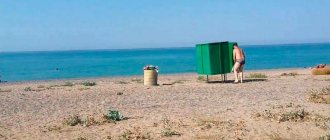There are many beautiful cities in Tatarstan. Among them, Bugulma is one of the largest regional centers in the country. Its history is rich in memorable events, including the famous Pugachev uprising. This beautiful and interesting regional center is worth a visit to get acquainted with its rich history and see the sights. The delightful nature of the city invites you to take long walks along its quiet, well-groomed alleys and lush vineyards. Here you can also go fishing and swim in the clean river water. Let's find out where Bugulma is and how to get there.
Where is the city of Bugulma?
Russia is a vast state, including many republics and regions. Where is Bugulma in Russia? Bugulma is the main administrative center of the Bugulma district in Tatarstan. The Republic of Tatarstan is part of Russia, like other regions and republics, and also has its own traditions that are unusual for the Russian Federation.
Located near Samara, 250 kilometers away.
Central mosque of the city
The largest city mosque is designed, like most Muslim places of worship, in snow-white colors. It is fenced with an openwork fence made of cast iron. This is a modern Muslim building with a characteristic volumetric planning solution. The design of the building displays motifs not only of Eastern Muslim, but also of Bulgarian architecture. Followers of Islam come here to pray. Tourists visit the mosque to admire its beautiful design and become familiar with the ancient culture. Look again how beautiful Bugulma is. A photo of the city and its central mosque is presented below.
Republic of Tatarstan
Tatarstan is a separate country within the Russian Federation with its own customs and holidays. The capital is the beautiful city of Kazan.
Where is Bugulma in Russia? The Republic of Tatarstan is located in the central part of the European side of the Russian Federation, if you look at the map, it is on the slopes of the Bugulma-Shugurovsky plateau, where vegetation predominates.
The area of which is 67836 square kilometers. Bugulma is located in the center of the Bugulminsky - Belebey upland, at the junction of two rivers:
- Volga;
- Kama.
The oldest museum
Coming to Tatarstan, many tourists are interested in where Bugulma is located in order to go to its famous local history museum. It is considered one of the oldest in the country. The museum was opened in 1929, on October 1. And for many years now he has been introducing guests to the history of the city and the country as a whole. Here you can get historical information about Bugulma, hear interesting facts about the Pugachev uprising, the Civil and Great Patriotic Wars. The establishment presents household items of various nationalities that once inhabited the city: Tatars, Chuvash, Mordovians, Russians. The local history museum has a nature department. Here you can get acquainted with the animal and plant world of the region, see mammoth tusks, a stuffed wolf and admire the magnificent collection of butterflies. The museum's exposition occupies 2 mansions that were built in the 20th century. One of them belonged to the adviser Yelachin, and the other was owned by the merchant Klimov. The Bugulma Museum of Local Lore is open daily from 08.00 to 17.00, except Sundays.
Bugulminsky district
The area of the district is not extensive and amounts to 1408 square kilometers. Located in the southeast of Tatarstan. The region borders Samara and Orenburg, Almetyevsk and Leninogorsk are located nearby.
The area is 67,836 square kilometers, and the highest point is a hill in the state nature reserve called Chatyr-Tau. Bugulma district includes 19 settlements:
- 17 rural;
- two city ones.
Economy
If you are wondering where Bugulma is in Tatarstan because you are thinking about moving there, you should find out about the economic situation in the city.
Of course, it is in many ways inferior to what it was during the Soviet period. First of all, this is due to the fact that in the 90s many enterprises closed, which led to a deterioration not only in the economic but also in the demographic situation in the city.
Currently operating in Bugulma:
- "Factory of reinforced concrete products";
- garment factory;
- Distillery;
- mechanical named after V. D. Shashina;
- ;
- meat processing plant;
- furniture factory;
- dairy plant;
- TNG-Group LLC;
- electric pump plant;
- brick ;
- Ak Bars Aero;
- and some other industrial enterprises.
The city also has an airport and a railway station.
Climate and weather
Bugulma district belongs to the southeastern part of the temperate climate zone. A temperate continental climate prevails here.
A characteristic feature of this area is a long autumn and constantly fluctuating winter temperatures.
The average winter temperature is minus 11.5 degrees. The weather in winter is characterized by long frosty months.
The summer weather doesn't last long, but the temperature stays at plus 18.8 degrees. The warm season is delicate and pleasant.
The story of Bugulma - how it all began
The future city of Bugulma and the district became an important milestone in history.
This city appeared after the fall of the Kazan and Astrakhan khanates, which caused military fortification measures in Moscow and throughout the Moscow state. When the Moscow state annexed new territories, it built defensive lines, which consisted of fortresses that protected the population who fled from the central regions of our country. Also, such fortresses served to suppress the local uprising of the indigenous population.
In the period 1651–1656, the Zakamsk defensive line was built, which was accompanied by settlement. People settle in military fortresses in nearby districts. Initially, the population consisted mainly of white-till Cossacks.
In the second half of the 17th century and at the beginning of the 18th, the indigenous population moved from the Middle Volga region to the Southern Urals and western regions of Bashkiria. This resettlement was a consequence of the reforms of Peter the Great, which became a heavy burden for the peasants.
Gradually moving south, the settlers developed more and more new lands. So, in 1706 they founded the Tatar Dymskaya, which is located on the territory of the current Bugulminsky district.
Story
The name of the city comes from the name of the river, which is called Bugulminka. In 1736, the first mention of the settlement “Bugulminskaya” was found in the chronicle, which arose on the site of a small village in the forest near the river, and nearby there was a road well-worn by merchants and merchants.
In 2021, the city turned 284 years old.
In 1773, the main headquarters of the Russian Empire was located here, which was engaged in suppressing the Pugachev rebellion. The territory of the city was transferred from one administrative entity to another, but by decree of Catherine II the city received the status of a county town on December 28, 1781.
Since 1851, Bugulma belonged to the Samara province. At this time, the appearance began to change, and in 1852 city elections were held for board membership.
Just half a century after its official formation, in 1781, the city received the status of a county town.
Bugulminskaya Sloboda was a place of settlement by Russians. It was not serfs who were resettled on the territory of the Bugulminsky district, but young soldiers with their families, and here they were sent into exile under supervision.
Bugulma is a center of trade. Roads from Ufa and Orenburg to the capital of Tatarstan passed through the city. Fairs were held here. The city developed and grew.
National composition in 1897
| Nationalities | % of total residents |
| Russians | 47 |
| Bashkirs | 30 |
| Tatars | 15 |
| Other nationalities | 8 |
In 1911, the Volgo-Bugulminskaya railway line was built through the city.
In 1920, in the Bugulma region, the main type of work was agricultural. Therefore, the city is full of such buildings as:
- mills;
- meat processing plant;
- creamery
Drama theater
The city of Bugulma (Republic of Tatarstan) has its own theatrical history, which began in the first half of the 20th century. But the theater troupe existed earlier - in the 19th century. So, in 1897, the People's House was built in the city, designed to accommodate 350 people. It included a theater with a hall. Every year, lovers of musical and dramatic art came up with theatrical productions, of which there were 20 by the beginning of 1908. Musical and literary evenings were also organized here. At the end of the revolution, another circle appeared called the “Blue Blouse”. Subsequently, the Bugulma Drama Theater was created on its basis. During the war, it was led by actress Nina Olshevskaya, a student of Stanislavsky. She was evacuated to Bugulma along with her son. It was in the Tatar town that her successful theatrical career began. Years later, the city drama theater was named in her honor. The theater building was restored for its 70th anniversary. Now it is a worthy decoration of Bugulma. The modern Bugulma Drama Theater operates all year round. It is located at the address: Lenin Street, building 96.
War years
In August 1941, during the Second World War, the 352nd Orsha Red Banner Rifle Division was created in Bugulma. These years were also marked by the construction of a tank column called “Komsomolets of Tatarstan”, which was created thanks to donations from city residents. From May 1944 to May 1945, the strategic bomber PE-8 “Bugulminsky collective farmer” flew.
1948 is a significant year, it was then that the Romashkinskoye oil field was discovered, and in 1950 the Tatneft organization was established; this time is truly considered the second birthday of the city.
"Tatneft" is the exploration of oil deposits and its production in the territory of Tatarstan. Then a transportation center and a scientific center were created to develop the production of “Black Gold”. Thanks to the mining work, the number of city residents increased several times in a short period of time.
In 1974, the general plan of Bugulma was designed under the leadership of Leningrad State University. Between the 1970s and 1990s the city expanded significantly.
Scientists from Moscow on December 12, 1976 translated the word “Bugulma”. As a result, the city could be called “Bykovka”. If you delve into the basics of the Turkic languages, it will become clear that the root of the word “Bug” is equal to the root “bull”. This information was covered by the program “In the World of Words” and most residents knew this feature, since almost everyone listened to the radio.
After the war
In 1948, the Romashkinskoye oil field was discovered in the vicinity of Bugulma. This event made many people interested in the question of where Bugulma is located.
In 1950, the Tatneft association was founded in the city. In connection with the active development of the Romashkinskoye deposit, in Bugulma in the early 50s the department for exploration and production of “black gold” was located in the entire Tatar Autonomous Soviet Socialist Republic. In addition, the TatNII was created there, as well as the oil transportation center (USZMN).
Thanks to this, within 10 years the population of Bugulma increased 10 times, and for a number of years, until the end of the 60s, it was the 2nd most populous city in the republic, after its capital Kazan.
In 1953, when asked in what region the city of Bugulma is located, where the Tatneft administration is located, they answered: “Bugulma region.” True, this was true only from February 21 to April 30, 1953.
Transport accessibility
There is a railway station in Bugulma that connects the city with many villages and towns:
- Ufa;
- Tuymazy;
- Almetyevsk;
- October;
- Leninogorsk.
The area has the Bugulma airport, which is located just 8 kilometers north of the city.
Bugulma consists of several streets in the center, which are adjacent to compact microdistricts. Scheduled public transport for residents includes:
- Shuttle Buses;
- Route taxis.
There is a bus station in the City, from which you can regularly travel to the desired city by bus:
- Samara;
- Orenburg;
- Permian;
- Kumertau;
- Nizhnekamsk;
- Magnitogorsk;
- Sterlitamak;
- Kazan;
- Izhevsk
Entertainment in Bugulma
There is plenty of entertainment in the city. On weekdays and weekends there is a theater, cafes, restaurants, bowling clubs, and billiards. Those who like to play sports or lead an active lifestyle should definitely visit the city’s Ice Palace and the Energetik sports stadium. Fans of intellectual games can go to the chess club. All tourists, without exception, are recommended to visit museums and the main drama theater of the city. History buffs will enjoy looking at the memorial complex dedicated to the Great Patriotic War. The Eternal Flame burns there and a model of the Pe-2 aircraft is installed. Some city streets are decorated with vintage cars, including the huge L-9669 steam locomotive, Fordson tractor and others. Those who come to Bugulma in early May will be able to attend the colorful celebration of Sabantuy.
Sanatoriums of Bugulma
The main attraction is the beautiful virgin nature. This is a real green corner among Tatarstan.
Near the city you can relax not only your soul, but also your body. There are a number of famous, modern sanatoriums and boarding houses.
Sanatorium-preventorium "Lilia"
The place of the sanatorium is imbued with its own energy, thanks to the local landscapes and clean air.
The sanatorium is located in the center of Bugulma and welcomes guests from all over the world.
Treatment profile of the sanatorium:
- problems in the musculoskeletal system;
- problems with the cardiovascular or nervous system;
- digestive organs;
- respiratory system.
- The health resort offers the following healing procedures:
- massotherapy;
- physical training;
- physiotherapy;
- drug treatment;
- galvanic mud and mud applications;
- various types of baths;
- halochamber.
An individual treatment plan is drawn up for each visitor; there are programs for adults and children.
Leisure activities:
- walks through the pine forest;
- operating herbal bar;
- Gym;
- pool;
- entertainment program in the evenings;
- excursions and others.
Sanatorium "Vita"
"Vita" is a modern medical and health institution. It has everything you need to provide quality services in a timely manner. Holidays in Tatarstan are a calm and soulful pastime that helps relieve stress and increase vitality.
The multidisciplinary three-story institution is located in the city of Bugulma near a picturesque park where you can take a walk in your free time from treatment.
The dispensary offers the following services:
- mud bath;
- sauna;
- pool with spring waters.
The entrance to the hospital is equipped with a ramp for small-sized citizens.
Temples of Bugulma
Not everyone knows where the city of Bugulma is located. But many have heard about the beautiful Bugulma temples:
- Kazan-Bogoroditskaya Church.
- Temple of St. S. Sarovsky.
- Church of the Nativity of I. Forerunner.
- Church of the Holy Great Martyr G. the Victorious.
It should be noted that in Tatarstan there are both Orthodox shrines and mosques, which will be described below.
The Orthodox Kazan-Bogoroditskaya Church was built between 1988 and 1993. It was erected in honor of the 1000th anniversary of the baptism of Rus'. Now this picturesque building with a four-tier bell tower is not only a place of prayer, but also a tourist attraction.
The Church of St. S. Sarovsky was built in 2006 with charitable funds. Divine services are held here on Sundays and holidays. There is a baptismal room in the basement.
The church in honor of St. John the Baptist is made of wood, so it has a special atmosphere of warmth and comfort. The temple is very attractive both outside and inside. It was illuminated in 1997 by Bishop Anastasius of Tatarstan and Kazan. Now it holds Sunday and holiday services.
The Church of the Holy Great Martyr G. the Victorious has been operating since 1999. It is made in white colors. A Sunday school is opened at the temple, and services are held here on Sundays and holidays.
Sights of Bugulma
Bugulma not only has a fascinating history, but also many memorials, parks and churches on its territory.
Since the area is located in the center of the Bugulma Upland, here you can find many springs that flow from underground.
Karabash Mountain
On a section of the spur of the Bugulma-Bebelevskaya Upland there is a slope leading to the sources of the Karabash reservoir. Here you can find rare plants and animals in a small area.
Avenue of Heroes
The alley was founded in honor of the 40th anniversary of the celebration of the anniversary of the Victory of the Soviet people in the Second World War in 1975. On the territory of the alley you can find 8 busts of participants in the Great Patriotic War, they are also Heroes of the Soviet Union and natives of the city and region.
Monument to the famous steam locomotive
In August 2011, a monument was erected in the city in honor of the 100th anniversary of the Bugulma railway station. The locomotive can be seen immediately upon arrival in the city at the central railway station. The locomotive carriage was specially repaired and painted. L-3401 is a Soviet mainline steam locomotive that was mass-produced in Bryansk from 1947 to 1955.
Fordson Tractor Monument
On the territory of the Bugulma Agricultural College you can see a monument to a tractor. The monument was erected here for a reason; it was here that training courses for future tractor drivers were organized. The monument of the monument was the original tractor “Fodzon-Putilovets”, which was released from the assembly line in the city of Petrograd in 1926.
Bugulma State Drama Theater named after A. V. Batalov
The cultural center was founded back in 1908. The theater building was originally built as a people's house with a hall for plays. Russian Drama Theater named after. A.V. Batalova is the center of professional theatrical art throughout the Republic. The theater was officially founded in 1935. During the war years, the theater was managed by the actress of the Red Army Theater - N. A. Olshevskaya. Together with her son, she was evacuated to Bugulma. In Soviet times, the theater troupe traveled around Tatarstan, Bashkiria and nearby territories. The theater was in demand and won the hearts of its audience with excellent performances on stage.
Only in 2008 the drama theater received a name in honor of the talented actor A.V. Batalov. This artist began his career in this theater.
Bugulma Museum of Local Lore
When compared with Russian cities, Bugulma is a small, average city. At 88 Herzen Street you can find an amazing place where many archival photographs are stored. Date of foundation: October 1, 1929. The museum is the oldest throughout Tatarstan. The museum clearly shows the entire history of the city, from its foundation to the present day. Among the exhibits you can find:
- newspapers;
- combat leaflets;
- telegrams;
- materials from the KGB archives.
The diversity of nature is also clearly visible in the museum's nature section.
Bugulma Mechanical is a mechanical plant that specializes in the production of equipment:
- oil production;
- processing of petroleum products;
- petrochemical and energy industries.
Thanks to the plant's products, Tatarstan, Russia and many other countries are provided with supplies in this area.
Apartment house of merchant Khakimov
The apartment building is one of the most famous ancient buildings in the city. In 1912, the first cinema was opened here, and the first floor was given over to retail.
Ice Palace "Yubileiny"
The ice palace has an arena for organizing mass skating with the possibility of renting skates. There is also a skate sharpening workshop.
Literary and Memorial Museum of Jaroslav Hasek
In addition to the local history museum in Bugulma, there is another memorable and significant place for the city. The Yaroslav-Hašek Museum on Sovetskaya Street, 67. This is the only museum of its kind.
The museum is located on the territory of the former military commandant's office. From October to December 1918, the Czech writer Hasek performed public service in the role of military commandant in Bugulminsky district.
Among the exhibits you can find:
- important documents;
- Personal Photos;
- collections of stories and essays;
- souvenirs.
The house includes a memorial room and 3 additional rooms.
Memorial of Eternal Glory
The 1960s were marked by the creation of this memorial. The wall of the monument is made of granite and concrete, and behind there is a stele with an unfurled flag. Marble slabs contain 5,560 names of people. In 2000, the memorial was expanded with additional exhibits:
- Tank - T34;
- Armored personnel carrier;
- Dive bomber PE-2.
Monument in honor of the 200th anniversary of the city of Bugulma
It is a sculpture of a man and a woman with their backs turned to a pillar.
Pre-trial detention center No. 3
This building keeps its history and mysteries for residents. Initially, in 1867, Bishop Gerasim of Samara and Stavropol consecrated the temple, giving rise to the formation of a women's community. It later formed into a convent, but in 1931, by decree of the Soviet government, the monastery was closed.
In 1934, pre-trial detention center No. 3 was formed here, since the former cells were suitable for cells.
Museum dedicated to Jaroslav Hasek
The history of the city of Bugulma will not be fully revealed if, after being there, you do not visit the famous museum named after. Yaroslav Hasek. He is known not only in Russia, but throughout Europe. The J. Hasek Museum can be seen only in two countries: Tatarstan and the Czech Republic. The famous building is located between ancient houses. At the entrance to the museum, guests are greeted by the brave soldier Schweik. And although this is only his sculpture, from afar it seems that a real military man is waiting for you. Previously, this house belonged to the merchant Nizheradze. In 1918, Jaroslav Hasek lived and worked within its walls. The writer stayed in the city for only 2 months, but this time was enough for Bugulma to win his heart. The old chairs on which Hasek sat remained in the museum. In one of the rooms you can see a forged chest, an antique desk with heavy drawers, and, of course, hear the chime of the famous French wall clock. The museum welcomes visitors daily from 08.00 to 17.00, except Sundays. The lunch break lasts from 12.00 to 13.00.
Coat of arms of Bugulma
Catherine II assigned the coat of arms to the city. Includes silver fish with blue spots.
In 2007, changes were made to the State Heraldic Register of the Russian Federation and the Republic of Tatarstan. Now the coat of arms contains 3 colors:
- Red symbolizes hard work, strength, courage and beauty.
- Green is a symbol of nature, agriculture and life growth.
- The color blue symbolizes honor, nobility and pure spirituality.
The fish depicted on the coat of arms is a symbol of abundance, and the hill indicates an elevated area in the Bugulma region.
How to get to Bugulma
The city can be found in the southeastern region of the Republic of Tatarstan.
From Moscow you can fly to Bugulma by plane, which departs from Domodedovo International Airport. The average travel time is 1.5 hours. And from the Kazan station to Bugulma there are electric trains. The average travel time is 24 hours. But by car it will take about 12 hours to get to the Tatar city. The Bugulma city index begins with the following numbers: 4232**. Well, the last information tourists need concerns telephone communications. Bugulma city code + 7–85514. There is no time difference with Moscow.
In the 19th century
From 1851 to 1920, the city was part of the Samara province.
For most of the 19th century, the city was an important trading center. The fact is that where Bugulma is located, there was a crossroads of several important roads. In particular, caravans heading from Ufa and Orenburg to Kazan passed through it.
150-160 years ago there were three annual fairs there. Of these, Vozdvizhenskaya took place from September 14 to 26 and was considered one of the largest in the Urals in terms of its turnover.
At the fairs held in Bugulma, horses, cattle, raw leather, Bukhara carpets and other goods from Central Asia, tea, leather goods, camel cloth, etc. were sold. Large transactions were concluded at them and a brisk retail trade was conducted.
By 1890, the city had five Orthodox churches, two hospitals and three educational institutions. There was a public bank, a zemstvo library, a post office and a telegraph office. A significant part of the population of Bugulma was employed in 40 factories, mainly brick, pottery, oil mills, etc. In addition, a public garden was laid out in the city, where a brass band played on Sundays and holidays.
At the turn of the 19th-20th centuries, people lived in Bugulma;
- 47% Russians;
- 30% Bashkirs;
- 15% Tatars;
- 8% - Chuvash and Mordovians.
